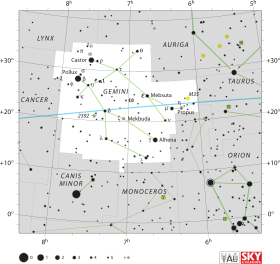DN Geminorum
| Ascension droite | 06h 54m 54,3493s[1] |
|---|---|
| Déclinaison | +32° 08′ 27,925″[1] |
| Constellation | Gémeaux |
| Magnitude apparente | +3,6 (max)[2] |
Localisation dans la constellation : Gémeaux | |
| Variabilité | Nova |
|---|
| Vitesse radiale | +6,3 ± 2 km/s[3] |
|---|---|
| Mouvement propre |
μα = −0,794 mas/a[1] μδ = −4,323 mas/a[1] |
| Parallaxe | 0,728 8 ± 0,080 7 mas[1] |
| Distance |
1 365+209 −108 pc (∼4 450 al)[2] |
| Magnitude absolue |
−7,6 (max) 4,4 (actuelle)[2] |
Désignations
DN Geminorum (ou Nova Geminorum 1912) était une nova qui survint en 1912 dans la constellation des Gémeaux. Elle atteignit une magnitude minimale (correspondant à une luminosité maximale) de 3,6. De nos jours, DN Geminorum a une magnitude de 14.
La mesure de sa parallaxe par le satellite Gaia permet de lui estimer une distance d'environ ∼ 4 450 a.l. (∼ 1 360 pc) du système solaire[2].
Nova Geminorum 1912 est une nova classique[5],[6],[7] découverte par l'astronome norvégien Sigurd Enebo (en) (-) le mardi, [8],[9],[10] à Dombås[8],[9].
DN Geminorum est un système binaire[11] dont l'objet primaire est une naine blanche[11] de 0,93 ± 0,15 masse solaire[12]. Son compagnon serait une naine rouge[13].
Selon l'historien des sciences Tilman Sauer, le contexte de la nova a motivé Albert Einstein (-) à effectuer ses premiers calculs sur la lentille gravitationnelle[14].
Notes et références
[modifier | modifier le code]- (en) A. G. A. Brown et al. (Gaia collaboration), « Gaia Data Release 2 : Summary of the contents and survey properties », Astronomy & Astrophysics, vol. 616, , article no A1 (DOI 10.1051/0004-6361/201833051, Bibcode 2018A&A...616A...1G, arXiv 1804.09365). Notice Gaia DR2 pour cette source sur VizieR.
- (en) Bradley E. Schaefer, « The distances to Novae as seen by Gaia », Monthly Notices of the Royal Astronomical Society, vol. 481, no 3, , p. 3033-3051 (DOI 10.1093/mnras/sty2388, Bibcode 2018MNRAS.481.3033S, arXiv 1809.00180)
- (en) Ralph Elmer Wilson, General Catalogue of Stellar Radial Velocities, Carnegie Institution of Washington, (Bibcode 1953GCRV..C......0W)
- Simbad.
- Retter, Leibowitz et Naylor 1999, résumé, p. 140.
- Selvelli et Gilmozzi 2019, résumé, p. 1.
- Thomas, Naylor et Norton 2008, résumé, p. 547.
- Bellamy 1912, p. 497.
- Cannon et Pickering 1912, p. 1.
- Pettersen 2012, § 3, p. 248, col. 1.
- Selvelli et Gilmozzi 2019, p. 1, col. 1.
- Selvelli et Gilmozzi 2019, table 1, p. 3.
- Retter, Leibowitz et Naylor 1999, p. 144, col. 1.
- Sauer 2008.
Voir aussi
[modifier | modifier le code]Bibliographie
[modifier | modifier le code]- [Bellamy 1912] (en) F. A. Bellamy, « Nova Geminorum 2 (Enebo) : its position for 1900.0, together with those for 102 stars surrounding the Nova, as deduced from measures on a photograph taken at the University Observatory, Oxford », Monthly Notices of the Royal Astronomical Society, vol. 72, no 6, , p. 497-506 (OCLC 6911090575, DOI 10.1093/mnras/72.6.497, Bibcode 1912MNRAS..72..497B, lire en ligne
 [PDF]).
[PDF]). - [Cannon et Pickering 1912] (en) Annie J. Cannon et Edward C. Pickering, « Nova Geminorum, No. 2 », Harvard College Observatory Circular, no 176, , p. 1-6 (Bibcode 1912HarCi.176....1C, lire en ligne
 [PDF]).
[PDF]). - [Pettersen 2012] (en) Bjørn Ragnvald Pettersen, « Sigurd Enebo and variable star research : Nova Geminorum 1912 and the RV Tauri stars », Journal of Astronomical History and Heritage, vol. 15, no 3, , p. 246-254 (Bibcode 2012JAHH...15..246P, lire en ligne
 [PDF]).
[PDF]). - [Retter, Leibowitz et Naylor 1999] (en) A. Retter, E. M. Leibowitz et T. Naylor, « An irradiation effect in Nova DN Gem 1912 and the significance of the period gap for classical novae », Monthly Notices of the Royal Astronomical Society, vol. 308, no 1, , p. 140-146 (OCLC 4643987988, DOI 10.1046/j.1365-8711.1999.02704.x, Bibcode 1999MNRAS.308..140R, arXiv astro-ph/9905375, résumé, lire en ligne
 [PDF]).
[PDF]). - [Sauer 2008] (en) Tilman Sauer, « Nova Geminorum 1912 and the origin of the idea of gravitational lensing », Archive for History of Exact Sciences, vol. 62, no 1, , p. 1-22 (OCLC 5648556650, DOI 10.1007/s00407-007-0008-4, JSTOR 41134270, Bibcode 2008AHES...62....1S, arXiv 0704.0963, résumé).
- [Selvelli et Gilmozzi 2019] (en) Pierluigi Selvelli et Roberto Gilmozzi, « A UV and optical study of 18 old novae with Gaia DR2 distances : mass accretion rates, physical parameters, and MMRD », Astronomy & Astrophysics, vol. 622, , article no A186 (OCLC 8675258388, DOI 10.1051/0004-6361/201834238, Bibcode 2019A&A...622A.186S, résumé, lire en ligne
 [PDF]).
[PDF]). - [Thomas, Naylor et Norton 2008] (en) N. L. Thomas, T. Naylor et A. J. Norton, « The decline in irradiation from the white dwarf in old novae », Astronomy & Astrophysics, vol. 483, no 2, , p. 547-556 (OCLC 4639144720, DOI 10.1051/0004-6361:20079163, Bibcode 2008A&A...483..547T, résumé, lire en ligne
 [PDF]).
[PDF]). - [Schwarzschild et al. 1912] (de) Karl Schwarzschild et al., « Nova (18.1912) Geminorum », Astronomische Nachrichten, vol. 191, no 3, , p. 45-50 (DOI 10.1002/asna.19121910306, Bibcode 1912AN....191...45., lire en ligne
 [PDF]). — Max Wolf, Carl Wilhelm Wirtz, Elia Millosevich, Félix de Roy, Paul Guthnick (en), Elis Strömgren (en), Ernst Hartwig, Karl Schiller (de), Kasimir Graff (en), Edward C. Pickering et Joan Voûte (en).
[PDF]). — Max Wolf, Carl Wilhelm Wirtz, Elia Millosevich, Félix de Roy, Paul Guthnick (en), Elis Strömgren (en), Ernst Hartwig, Karl Schiller (de), Kasimir Graff (en), Edward C. Pickering et Joan Voûte (en).
Lien externe
[modifier | modifier le code]- [Simbad] (en) DN Geminorum sur la base de données Simbad du Centre de données astronomiques de Strasbourg.
